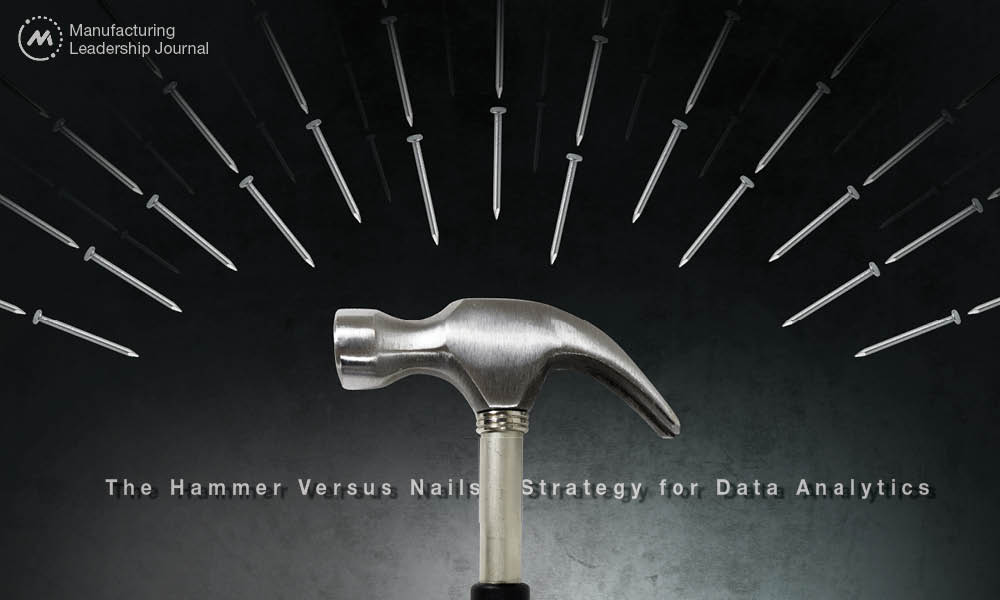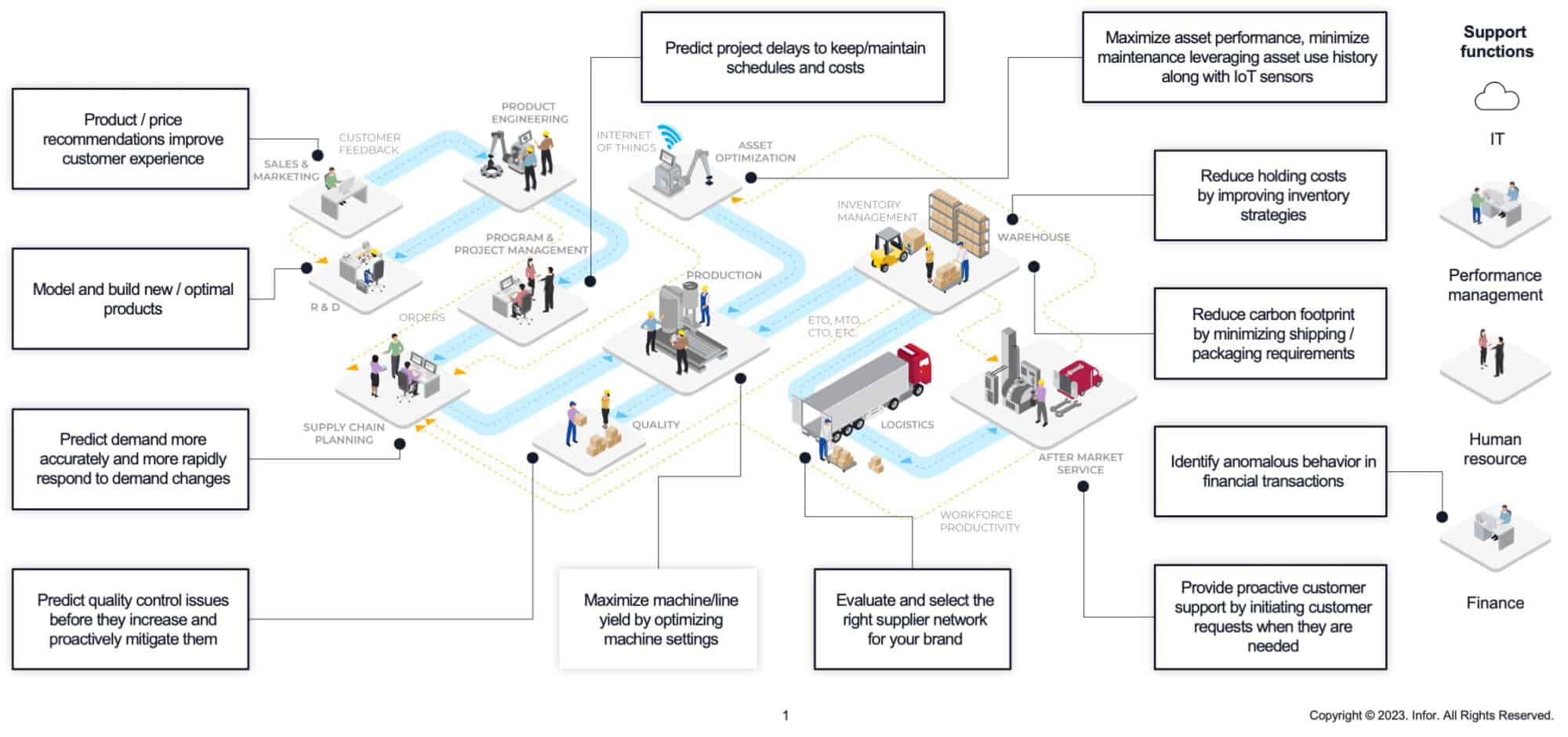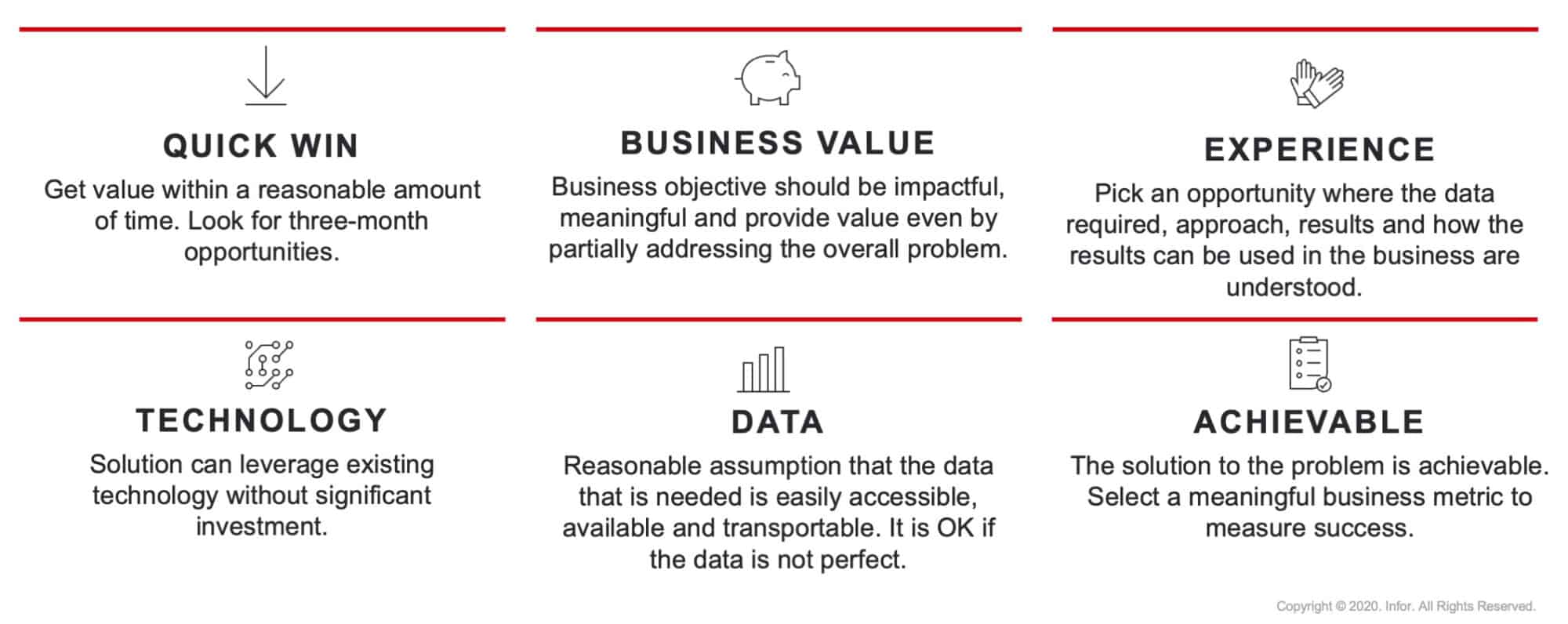The Hammer Versus Nails Strategy for Data Analytics

Taking a pragmatic approach to data analytics by focusing on business goals rather than technology allows companies to deliver incremental value.

TAKEAWAYS:
● Many developments in AI/ML for manufacturing can be leveraged now.
● The challenge is driven by people, technology, and process.
● An agile and pragmatic business centric approach can allow for tangible benefits without the high upfront investment.
Manufactures continue to exist in a complex juxtaposition of needing to significantly invest in technology to improve business operations, while still navigating difficult supply chain issues that require keeping costs down and focusing on retaining talent. Given a choice, the natural tendency is to pick the path of known and least resistance. But if the choice requires a difficult decision, sometimes no choice at all is the most likely outcome.
The use of data to drive better and faster business decisions is a necessary component of any executive strategy. Data is the next elixir in the quest to improve operational margins in the same way that cloud infrastructures allowed businesses to grow and transform over the last decade.
The use of machine learning to examine and augment the decision-making process is a similar and exciting extension of data driven decisioning. For example, on the shop floor AI is used to reduce scrap by identifying defective products as well as providing recommended changes to machine and process settings to prevent future issues. AI is also becoming heavily integrated in asset-intensive facilities to analyze sensor data and prevent downtime by alerting operators on potential issues. Beyond asset performance management, companies can also leverage shift and production information to improve workforce planning and management. With all the challenges in supply chains, having visibility into future issues also allows for improved spare parts management of operations.

“It is important to remember that the explosion of data use requires an ever-increasing focus on governance strategies as well as security.”
The benefits of better understanding the business from the prism of data is not constrained to factories alone. Think of how important it is to manage a successful organization by having visibility into cashflow or being able to forecast sales orders and expected product production needs. Beyond the internal business, external customers are also increasingly requesting more transparency into supply chains. The expectation is that product passports will be the next great investment in infrastructure.
The illustration in Fig. 1 highlights the importance of thinking about data analytics across multiple operations as a way to drive the business forward.
Fig. 1: Data Analytics Opportunities in Manufacturing

It is important to remember that the explosion of data use requires an ever-increasing focus on governance strategies as well as security. Data needs to be protected and carefully curated for safe and effective business purposes. Most companies have multiple business solutions in a variety of cloud and non-cloud systems and the investment in managing, consolidating, and reporting for those systems will only increase. At any given time, there are also ongoing IT projects to move, change, update, or replace existing systems in many organizations. The impact on business operations can be significant, especially as the workforce must continue learning and adapting to changing technology and business conditions, combined with talent retention challenges as new employees struggle to adjust to old systems.
It is perhaps no surprise that this can be overwhelming combination of factors for manufacturers to cope with.
The Hammer Approach
The best-case scenario is to be able to plan out your business operations as a digital blueprint and track the materials to goods to customer order (and their use) so that you can leverage all the latest innovations to drive quick and proactive decision making.
This is a significant effort and best done in the initial stages of a digital transformation when there are fewer moving pieces. The company can then focus on automating more of its manufacturing systems. Once a company has a digital twin of its key systems, it is easier to make process and technology decisions in harmony with business priorities. Investing in IoT sensors and vision systems to augment your software and infrastructure setup then helps prepare the way for future innovation capabilities.
It is recommended that while building data models companies also consider the different personas who will need access to the systems, their data access rights, as well as what kind of decision or action data needs to be captured to improve the intelligence of the entire business operation.
Other considerations would be around how to manage a data mesh of interconnected systems so there is reduced data duplication and retention. It is certainly more effective to invest in the right analytics when you start from a cleaner slate.
It is easy to get caught up in technology and forget business objectives.

“Once a company has a digital twin of its key systems, it is easier to make process and technology decisions in harmony with business priorities.”
The famous quote by Abraham Maslow: “If the only tool you have is a hammer, you tend to see every problem as a nail,” best describes problems with the hammer approach if you have an over reliance on technology versus solutions.
If the focus on IT infrastructure and software drives strategy and investment, organizations feel the burden of trying to rationalize the investment by looking for very specialized and potentially time consuming and expensive challenges. They end up investing in internet of things (IoT) sensors and storage infrastructure for this information without a clear plan on how to maximize their use. They can also resort to streaming analytic dashboards as way to visualize the information without a clear business driver. There is a great temptation to invest in additional hardware and streaming devices like cameras to leverage the data architecture use. The hammer approach is normally common in organizations that are understaffed or have limited experience with data driving decisions.
The hammer approach is a technology first and only approach to data analytics.
The Nails Decision Strategy
The “nails” are business challenges or goals. All organizations have them and expect them to change as often as needed. Nails are shared focus areas which executives want to move forward as part of a plan to improve their business incrementally.
To be thoughtful and organized is important, and to think of innovation as a “fail forward” approach. Due to the complexity of modern supply chains and plethora of operations systems there is a need to have a top-down executive alignment on an agile business benefit driven transformation plan. Change management is easier if there are quick wins with tangible benefits. Often priorities change faster than the time it takes some IT projects to complete, so it is best to focus on quick time to value.
The six pillars are important guiding principles in employing innovation in manufacturing. Companies can apply them to drive analytic decision making when picking their business goal “nails”.
Fig 2: Six Pillars of Analytics Decision Making

For machine learning driven analytics the availability of data is essential but since it is challenging and almost impossible to get perfect or complete data, the best approach is to reverse engineer the goals to be based on pragmatic business outcomes. A successful approach is to compartmentalize the type of data used in decision making. Evaluate and identify useful data that drives expected business outcomes versus where it does not, and then leverage it where it applies, versus a big bang approach.
While manufacturers have invested in sensors to track equipment performance, there are also pragmatic models that can use asset maintenance history to improve insights into maintenance scheduling versus simple time-based maintenance plans. Applying gradual data enrichment processes allows companies to gently bring in new and additional information where there is sufficient business benefit.
Engaging experienced plant supervisors and operators in leveraging any analytics so there is a way to improve work automation and process is an important tenant in maximizing the use of these tools.
A Pragmatic Approach
With this challenging environment most companies rightfully hesitate to invest significantly in changing their mental approach to leveraging data for business decisioning. The approach each business takes will depend on their culture and priorities, but approaching individual challenges and analytics requirements is an easier and faster way to fully realize priorities. The quick wins can engage all the departments of the business in a more collaborative manner and the investment decisions then tend to be less burdensome.
There is a need to prioritize data management strategies to leverage new analytics innovations in manufacturing and supply chains. How companies go about it does not need to overwhelm their focus.
Focusing on concise business goals (nails) and investing in quick wins is a better approach than building a technology first (hammer) solution. M
 About the author:
About the author:
Sandeep Anand is Senior Director of Decision Analytics and Science Platform at Infor. He has over 15 years of experience building and delivering AI/ML solutions. Experience includes solutions around yield/scrap , supply chain improvements and smart asset management strategies. He leads the AI/ML practice at Infor, a leading enterprise cloud solutions provider.